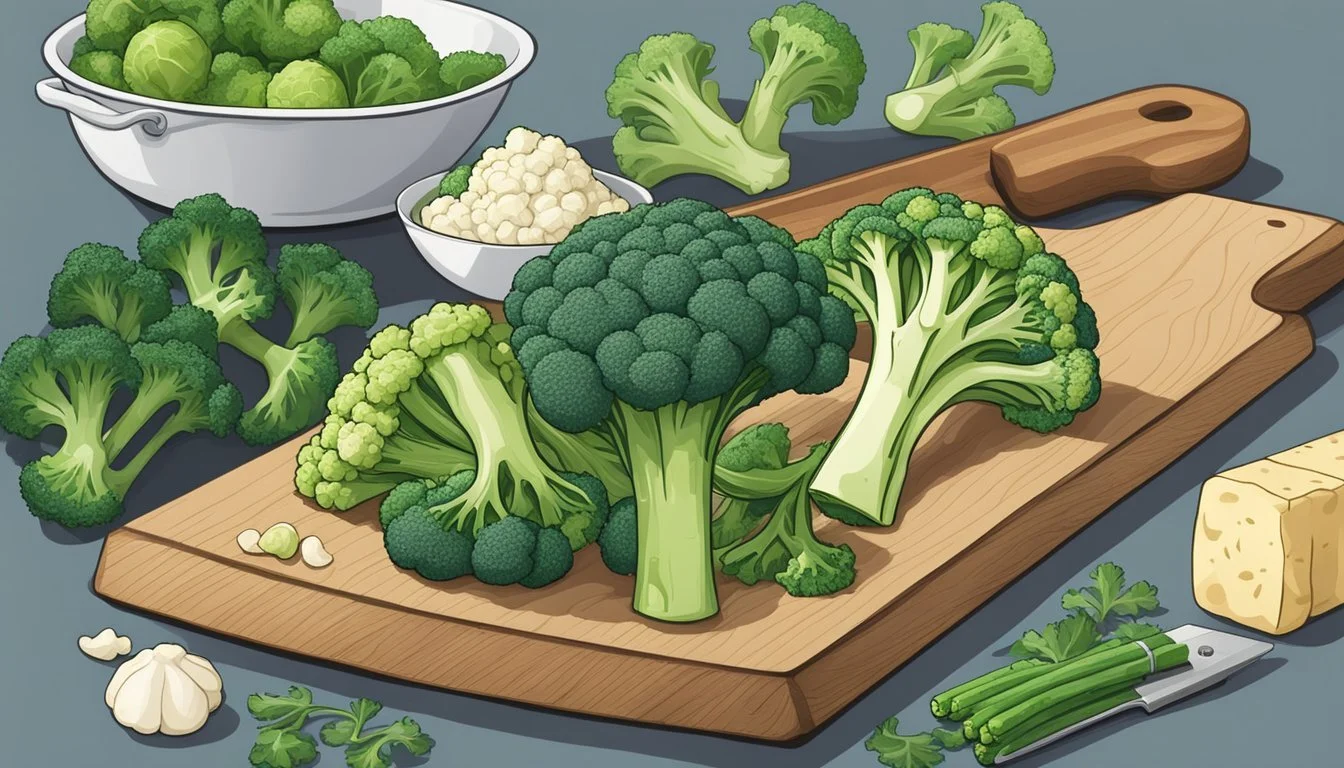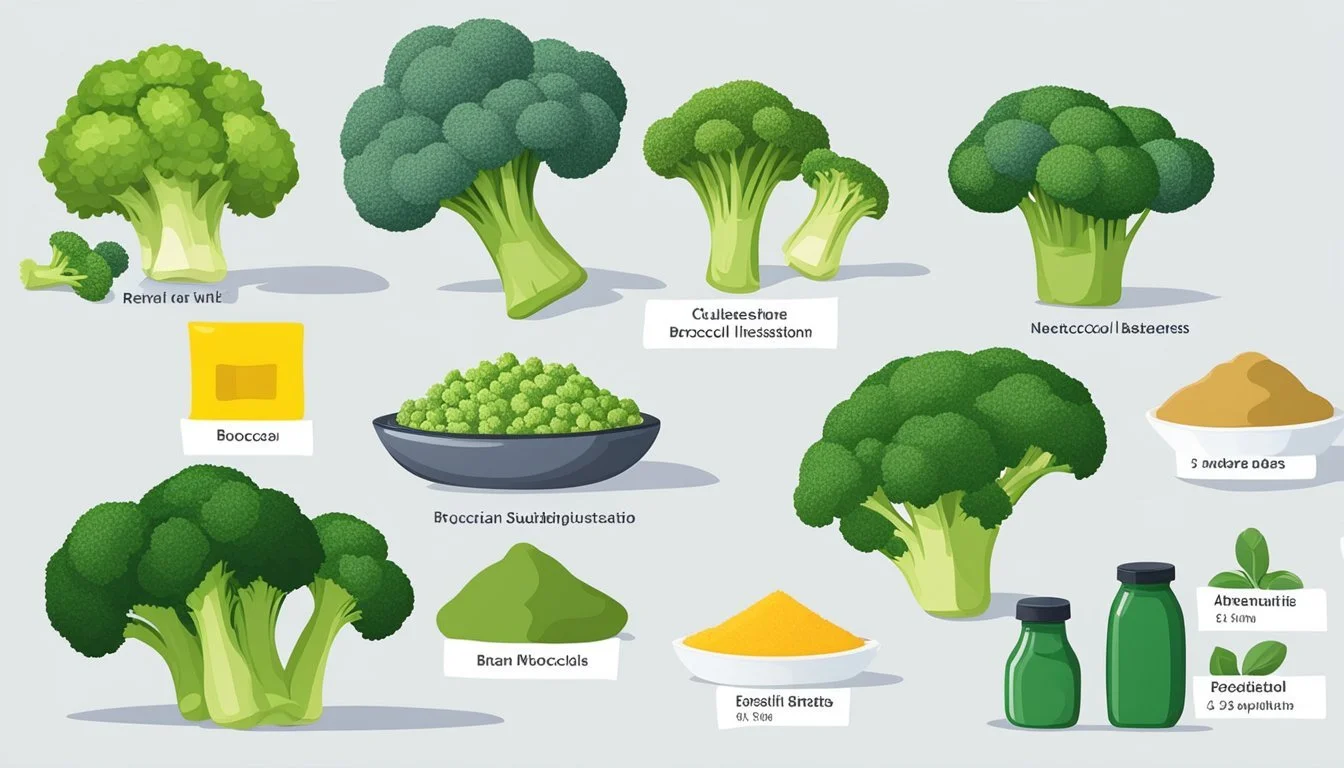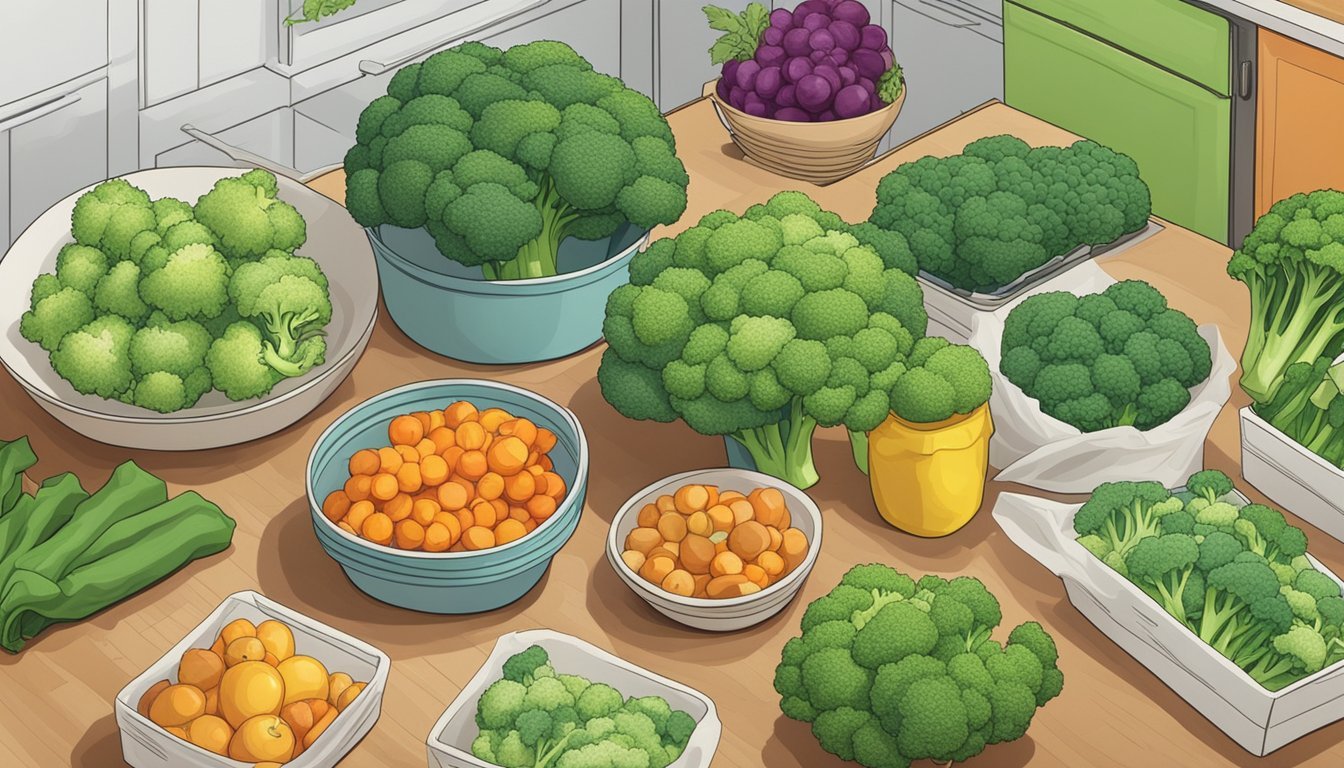Broccoli Substitutes
Top Alternatives for Your Recipes
When cooking a dish that calls for broccoli, it's not uncommon to find oneself in a situation where this cruciferous vegetable is unavailable or undesirable for a range of reasons. Perhaps it's a matter of taste preference, dietary restrictions, or simply a matter of availability at the local market. In any case, the versatility of broccoli means that finding an adequate stand-in can be crucial to the success of a meal. There are several options that can fill the void left by broccoli in both flavor and nutritional profile.
Cauliflower stands out as the most prominent substitute for broccoli, due to its similar texture and shape. This makes cauliflower an excellent option for many dishes, including stir-fries, casseroles (What wine goes well with casseroles?), and soups. It can also be prepared in much the same way as broccoli – steamed, roasted, or raw in salads. For those looking to maintain the green color in their dishes, alternatives such as asparagus, bok choy, and kale can offer a similar visual appeal along with distinct flavors that complement a variety of recipes.
Some substitutes, like cabbage and Brussels sprouts, may bring different textures and flavors to a dish, but they can still provide the desired bulk and nutritional benefits. These vegetables are particularly useful in cooked preparations, where their differing flavors can enhance the overall taste profile. In essence, these broccoli substitutes can not only salvage a meal but also introduce new dimensions of flavor and texture, making them worthy additions to any kitchen's repertoire.
Understanding Broccoli Substitutes
Identifying an appropriate substitute for broccoli requires consideration of its culinary role, nutritional benefits, and unique sensory attributes. In choosing an alternative, one must match these characteristics closely to maintain the intended outcome of a dish.
Culinary Roles of Broccoli
Broccoli serves as a versatile food that can be a main ingredient, side dish, or additive to enhance meals with its texture and nutritive value. It excels both in raw and cooked forms, often found in salads, stir-fries, soups, and casseroles.
Main Ingredient: In dishes like broccoli soup or puree.
Side Dish: Sautéed, steamed, or roasted alongside proteins.
Additive: Chopped in pastas, rice dishes, and quiches for extra texture and flavor.
Health Benefits and Nutrition Profile
Broccoli is celebrated for its rich nutrition profile, high in fiber, protein, and an array of vitamins and minerals such as vitamin C, vitamin A, calcium, and iron. It's considered highly nutritious and beneficial for health.
Fiber: Crucial for digestive health.
Protein: Important for muscle growth and repair.
Vitamins & Minerals: Support overall health and immune function.
Sensory Attributes: Flavor and Texture
The sensory qualities of broccoli—its flavor and texture—are significant in determining a suitable substitute. Broccoli has a distinctive yet subtle earthy flavor, which can be both slightly bitter and sweet, and a firm texture that softens upon cooking but retains a pleasant crunch.
Flavor: Earthy, with a balance of bitter and sweet notes.
Texture: Crunchy when raw, tender when cooked.
When selecting alternatives, it’s essential to align these elements to achieve a similar taste and textural experience, ensuring the substitute complements the other components of the dish without compromising its integrity.
Vegetable Alternatives to Broccoli
Broccoli is universally recognized for both its nutritional value and culinary versatility. However, when it's unavailable or a change in flavor is desired, there are several vegetable alternatives that can supply similar textures and health benefits.
Green Leafy Substitutes
Kale: The robust nature of kale offers a nutrient-dense substitute, providing high levels of vitamins A, C, and K, along with valuable fiber, iron, and calcium.
Spinach: For a softer texture, spinach serves as an excellent swap with its mild flavor, making it suitable for uncooked dishes or a gentle wilt in cooked meals.
Collard Greens: These can stand-in for broccoli's hearty texture when cooked, and offer a comparable nutritional profile featuring vitamins, minerals, and antioxidants.
Swiss Chard: Swiss chard brings vibrant colors and a slightly sweet taste to the table, fitting for a nutritious boost in salads and sautés.
Cruciferous Vegetable Alternatives
Cauliflower: It mirrors broccoli's shape and texture and can be used interchangeably in most recipes, while its white color offers a visual variation.
Broccolini: A hybrid of broccoli and Chinese kale, broccolini provides a more delicate taste and stem, which is ideal for quick cooking methods like stir-frying.
Bok Choy: Its crisp texture and subtle sweetness make bok choy a favorable addition, particularly in Asian-inspired dishes.
Chinese Broccoli: Also known as Gai-lan, it delivers a slightly bitter taste and is traditionally used in Chinese cooking, often steamed or sautéed with garlic.
Unique Vegetable Substitutes
Broccoli Rabe: Despite its name, broccoli rabe isn't a type of broccoli, but it offers a bitter, nutty flavor that stands out, particularly in Italian cuisines.
The above vegetables not only provide diversity in taste and nutrition but can also introduce new dimensions to familiar dishes typically made with broccoli.
Cooking Techniques for Broccoli Substitutes
When preparing broccoli substitutes, selecting the appropriate cooking method is essential to achieve a texture and flavor that closely resembles that of the original vegetable. Proper technique ensures that substitutes maintain their unique qualities while providing a similar dining experience.
Steaming and Blanching
Steamed vegetables retain most of their nutrients and mimic the tender-crisp texture of broccoli. To steam cauliflower, a popular substitute, one should:
Fill a pot with an inch of water, bring to a simmer, and place a steamer basket with cauliflower florets on top.
Cover and steam for 4-6 minutes until tender.
For blanching, it's key to have a bowl of ice water ready. The process for green beans, another substitute, is as follows:
Boil water in a large pot with a pinch of salt.
Add green beans and cook for 2-3 minutes.
Transfer immediately to the ice bath to halt the cooking process.
Grilling and Roasting
Grilling and roasting bring out a substitute's natural sweetness and can enhance flavor with the addition of marinades or seasoning. When grilling asparagus:
Toss spears with olive oil, salt, and pepper.
Grill over medium-high heat for 2-4 minutes on each side until charred and tender.
Roasting cauliflower requires:
Tossing the florets with olive oil, salt, and pepper.
Spreading them on a baking sheet and roasting at 425°F (220°C) for 20-25 minutes.
Boiling and Stir-Fry
Boiled vegetables work well in soups and purees, where they can replace broccoli. To boil bok choy:
Cut bok choy into pieces and add to a pot of boiling water.
Cook for 1-2 minutes until the stalks are tender yet crisp.
For a broccoli-like stir-fry using kale:
Heat oil or butter in a pan over medium heat.
Add kale and season with salt, pepper, and a splash of oyster sauce.
Stir-fry until the leaves are wilted and the stems are tender.
Each broccoli substitute can be adapted with these techniques to suit various dishes where broccoli would typically be used, accommodating personal preferences and dietary requirements.
Recipe Adaptations with Broccoli Substitutes
When preparing dishes that traditionally include broccoli, chefs can maintain the intended flavors and nutritional value by selecting suitable substitutes. Each alternative can cater to dietary restrictions or taste preferences in different types of recipes.
Vegetarian and Vegan Dish Modifications
For vegetarian and vegan dishes where broccoli is a key component, cauliflower stands out as the ideal replacement with its comparable texture and mild taste. It seamlessly incorporates into stir-fries and salads, often preferred slightly sweeter than broccoli, thus appealing to a broader palate range. Chefs should focus on consistency, ensuring that the substitute complements the existing flavors of the original recipe.
Example: For a broccoli-based vegan stir-fry, use chopped cauliflower as a direct 1:1 substitute.
Gluten-Free and Low-Carb Adjustments
With the growing demand for gluten-free and low-carb options, vegetables like cauliflower and asparagus offer a nutritious alternative to broccoli without compromising dietary needs. They can be introduced into various dishes where broccoli is usually the main star, providing similar vitamins and minerals.
Modification Tip: Replace a portion of the flour in gluten-free recipes with pureed cauliflower for a healthier, lower-carb version of the dish.
Dairy Substitute Integration
In recipes requiring a combination of broccoli and dairy, such as casseroles and soups, chefs might need to adjust the consistency and flavors when using broccoli substitutes. Cauliflower can be used in place of broccoli, absorbing the flavors of milks or dairy substitutes without altering the texture of the dish significantly.
Kitchen Note: When using a combination of dairy or milk alternatives and cauliflower, chefs should taste and adjust seasonings as necessary, since some milk substitutes may bring a slight sweetness to the dish.
Seasoning and Flavoring Broccoli Substitutes
When substituting for broccoli, it is crucial to consider how seasonings and flavorings will complement the texture and natural taste of the substitutes. Optimal seasoning can enhance their flavor profile and ensure they serve as worthy stand-ins in dishes where broccoli is traditionally used.
Herbs and Spices
Basil: It pairs well with milder substitutes like cauliflower, adding a sweet and peppery taste.
Garlic Powder: A versatile spice that complements nearly all broccoli substitutes, offering a warm, savory depth.
Dried Oregano: Its earthy and slightly bitter notes marry well with kale and cabbage.
Fresh Dill: Works especially well with green beans and asparagus, providing a grassy and citrusy flavor.
Crushed Red Pepper: Adds a spicy kick to substitutes, enhancing their palatability for those who enjoy heat.
Substitute Herbs and Spices Cauliflower Basil, Garlic Powder, Dried Oregano Green Beans Fresh Dill, Crushed Red Pepper Asparagus Fresh Dill, Garlic Powder Kale Garlic Powder, Crushed Red Pepper Cabbage Dried Oregano, Basil
Sauces and Oils
Olive Oil: Ideal for roasting or sautéing substitutes, offering a fruity undertone that does not overpower the vegetables.
Oyster Sauce: Its thick consistency and umami flavor work well in stir-fries with any broccoli substitute.
Butter: When sautéed with substitutes, butter adds a rich, creamy texture to the dish.
Salt and Pepper: These fundamental seasonings should be used to taste, enhancing the natural flavors of the substitutes without dominating them.
Substitute Sauces and Oils Cauliflower Olive Oil, Butter, Oyster Sauce Green Beans Olive Oil, Butter Asparagus Olive Oil, Oyster Sauce Kale Olive Oil, Butter Cabbage Butter, Oyster Sauce
The judicious use of herbs, spices, sauces, and oils can transform and elevate the flavor of broccoli substitutes to create satisfying and delicious meals.
Nutritional Information of Broccoli Substitutes
When seeking alternatives to broccoli, it is important to consider the nutritional profile of potential substitutes, specifically their micronutrient content and the levels of dietary fiber and protein they offer.
Micronutrient Content
Cauliflower, as a prime substitute for broccoli, not only resembles its appearance but also shares a similar micronutrient composition. It is a good source of vitamins such as vitamin C, potassium, and folic acid. However, when compared to broccoli, it generally has lower levels of vitamins A, C, and K.
Kale stands out for its high vitamin A, C, and K content, and provides more calcium, iron, and other minerals than broccoli. This makes kale an excellent choice when looking to boost the intake of these micronutrients.
Dietary Fiber and Protein Levels
Regarding dietary fiber and protein, kale offers more than broccoli, making it advantageous for those looking to increase their intake of these nutrients. Kale is noted for its rich fiber content as well as its iron and calcium levels, all of which contribute to a balanced diet.
Cauliflower, while similar in texture to broccoli and useful as a substitute in various recipes, contains less fiber and protein. It's important to be aware that if cauliflower is being used to replace broccoli, one might be receiving slightly less of these nutrients.
Both kale and cauliflower are low in calories and carbohydrates, making them suitable options for those monitoring their energy intake.
Creative Uses of Broccoli Substitutes
Exploring the world of broccoli substitutes not only caters to dietary restrictions and preferences but also injects a fresh twist into traditional dishes. This section showcases how substitutes can revolutionize side dishes and main courses.
Innovative Side Dishes
Cauliflower stands as the champion of broccoli substitutes, particularly for side dishes. It boasts a similar texture and can be roasted, steamed, or sautéed to serve alongside main courses. Cauliflower rice is a compelling, low-carb alternative to traditional side dishes. A simple process of grating and light cooking transforms this vegetable, offering a nutritious complement to any meal.
Chinese kale, also known as gai lan, is a leafy green that can be blanched and served with a drizzle of oyster sauce or soy sauce for an Asian-fusion side.
Broccoli rabe, despite being slightly more bitter, works well when sautéed with garlic and red pepper flakes; a palate-pleasing side dish that pairs nicely with robust entrees.
Main Course Variations
For main courses, substitutes like rapini (another term for broccoli rabe) and Chinese kale offer depth with their distinct flavors. They can replace regular broccoli in pastas, stir-fries, and casseroles.
Rapini becomes a star in Italian and Mediterranean dishes due to its slightly pungent taste, often blanched and incorporated into pasta with sausage or white beans.
Rapini Dish Components Preparation Style Rapini, sausage, white beans Sautéed, Blanched Rapini, garlic, pasta Boiled, Stir-fried
Chinese kale, with its sturdy stems and tender leaves, adds textural variety to stir-fries and noodle dishes.
Chinese Kale Dish Components Preparation Style Chinese kale, beef, noodles Stir-fried, Braised Chinese kale, garlic, tofu Steamed, Sautéed
These creative uses highlight how easily one can integrate broccoli substitutes into their cooking repertoire, maintaining nutritional value while expanding the range of flavors on their plate.
Shopping and Storage Tips for Broccoli Substitutes
When shopping for broccoli substitutes, consumers should look for fresh vegetables with vibrant colors and firm textures. Cauliflower, noted for its similarity to broccoli, should have a uniformly white or cream color without dark spots. Asparagus should be green with tight, closed tips, while kale should have a deep, rich color and be free from wilting.
Upon bringing these vegetables home, proper storage is key to maintaining their freshness and nutritional value. Cauliflower can be stored in a plastic bag in the refrigerator's crisper drawer for up to a week. It's important not to wash it before storing to prevent moisture buildup, which can lead to spoilage.
Asparagus keeps best when stored upright in a container with water at the bottom, much like a bouquet of flowers, and should be covered with a plastic bag. This method can extend its shelf life for about four days.
For leafy greens like kale, moisture is a consideration as well. They should be stored in airtight containers after being washed and thoroughly dried. Placing a paper towel inside the container can help absorb excess moisture.
Cabbage, another substitute, requires cool, dry conditions and can last up to two weeks if stored properly in the fridge. All substitutes should be checked frequently for signs of spoilage, such as soft spots or unpleasant odors, and should be used promptly to ensure the best flavor and texture.
Vegetable Shopping Tip Storage Method Lasts Up To Cauliflower Look for firm, white florets In a plastic bag, unwashed, in the fridge 1 week Asparagus Choose green stalks with tight tips Upright in a container with water, covered 4 days Kale Select richly colored, unwilted leaves In an airtight container with a paper towel 5 days Cabbage Opt for heads that feel heavy for their size Whole in the fridge, cool and dry 2 weeks
By following these tips, one ensures their broccoli substitutes remain as fresh and nutritious as possible until they're ready to be enjoyed.
Conclusion
In the quest for culinary flexibility, home cooks have a range of options to replace broccoli in their dishes. Cauliflower stands out as a top choice due to its similar texture and taste, though slightly sweeter, which might appeal to a broader audience. It can be effortlessly integrated into recipes calling for broccoli, with excellent results in stir-fries, salads, and more.
Asparagus offers a distinct flavor and is particularly well-suited to steamed or grilled preparations. Its compatibility with pasta dishes and stir-fries makes it an alternative that’s both visually appealing and flavorful. Cabbage, while differing in texture, is another adaptable vegetable that can take on a central role in stir-fry dishes and salads.
When assessing substitutes, one must consider nutritional profiles as well. Kale, for instance, is nutrient-dense, providing vitamins A, C, and K, along with fiber, iron, and calcium. It stands not just as a substitute but as a culinary choice that can enhance the healthful qualities of any meal.
Substitutes open up a world of possibilities in the kitchen, enabling cooks to tweak classic recipes or innovate new ones, ensuring that dietary preferences or constraints never dull the vibrancy of home cooking. Each alternative brings its own set of characteristics that can enliven dishes and cater to different palates while keeping meals nutritionally balanced.









